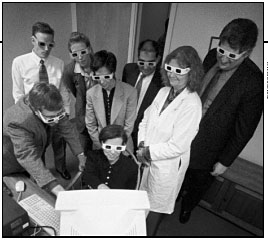The eyes have it: 3D video streaming is full of promise
It was a scene right out of the '50s—reminiscent of moviegoers sporting 3D glasses as they took in three-dimensional movies, the latest fad. The fad never caught on, but this recent event was not an amusing artifact of the entertainment world; rather, it was a historical moment in the medical world.
First: What is believed to have been the first 3D video streaming presentation over the World Wide Web occurred recently at DHMC. Video streaming is a way of transmitting video images over the Internet; with the use of 3D glasses, the images appear three-dimensional to an individual viewing them on a computer anywhere in the world.

|
|
The medical applications of 3D video streaming promise to be significant. |
The history-making presentation enabled members of the executive board of a nonprofit organization called Orbis to view a teaching conference on digital retinal angiography that took place at DHMC. Orbis is a global humanitarian organization that brings hands-on training, public health education, and improved access to eye care to developing countries.
Rosalind Stevens, M.D., chief of ophthalmology at DHMC and a longtime volunteer with Orbis, says the organization's mission "supercedes cultural barriers." The new 3D technology promises to supercede practical barriers as well—making it possible to send advanced educational presentations to an Internet-equipped computer located anywhere in the world.
The presentation used a video streaming product called TurboCast. Video and audio from a standard videoconference system appeared on one side of the viewers' computer screen, and a 3D PowerPoint representation of the presenters' slides on the other side. The Orbis board members simply donned inexpensive, cardboard-framed glasses with one green lens and one red lens to view the stereo digital fluorescein images. The glasses enhanced their depth perception, allowing them to better see the subtle eye abnormalities that were the topic of the presentation.
Efficiency: Patrick Saine, director of ophthalmic photography at DHMC, says Internet transmission of such presentations offers "a tremendous opportunity to increase the efficiency of international ophthalmic education." Both he and Stevens have traveled widely with Orbis to share their knowledge—from Cuba to Vietnam to Bulgaria. Now, 3D video streaming will make it possible for such instructional presentations to travel even more widely. "Besides the obvious cost efficiencies," adds Saine, "these technologies will facilitate a continuing dialogue between teaching physicians . . . and local physicians who are hungry for the latest in medical information."
Connectivity: The most promising aspect of the new technology is that TurboCast requires no special software and can run on a 28.8K modem. "Speed and easy connectivity are critical," explains Raymond Kulig, manager of video-conference and distance learning services for DHMC. "Many Third World countries do not have high-speed data lines and lack the resources to expertly install special software on their computers."
A further demonstration of the technology is planned for the next meeting of the American Academy of Ophthalmology.
Alan Smithee
If you would like to offer any feedback about this article, we would welcome getting your comments at DartMed@Dartmouth.edu.
